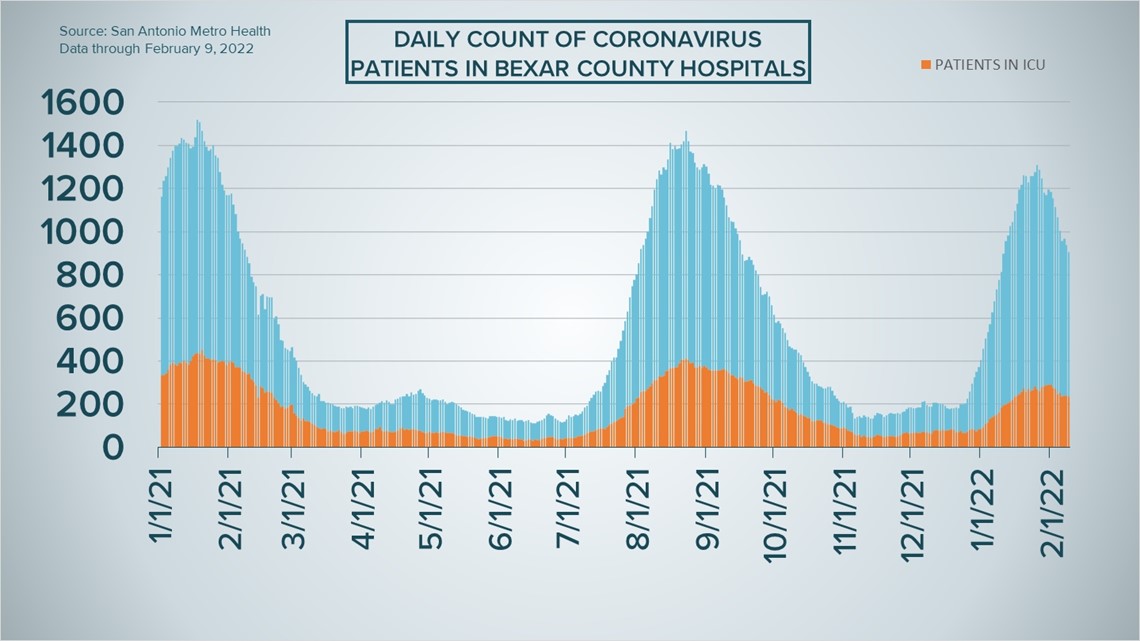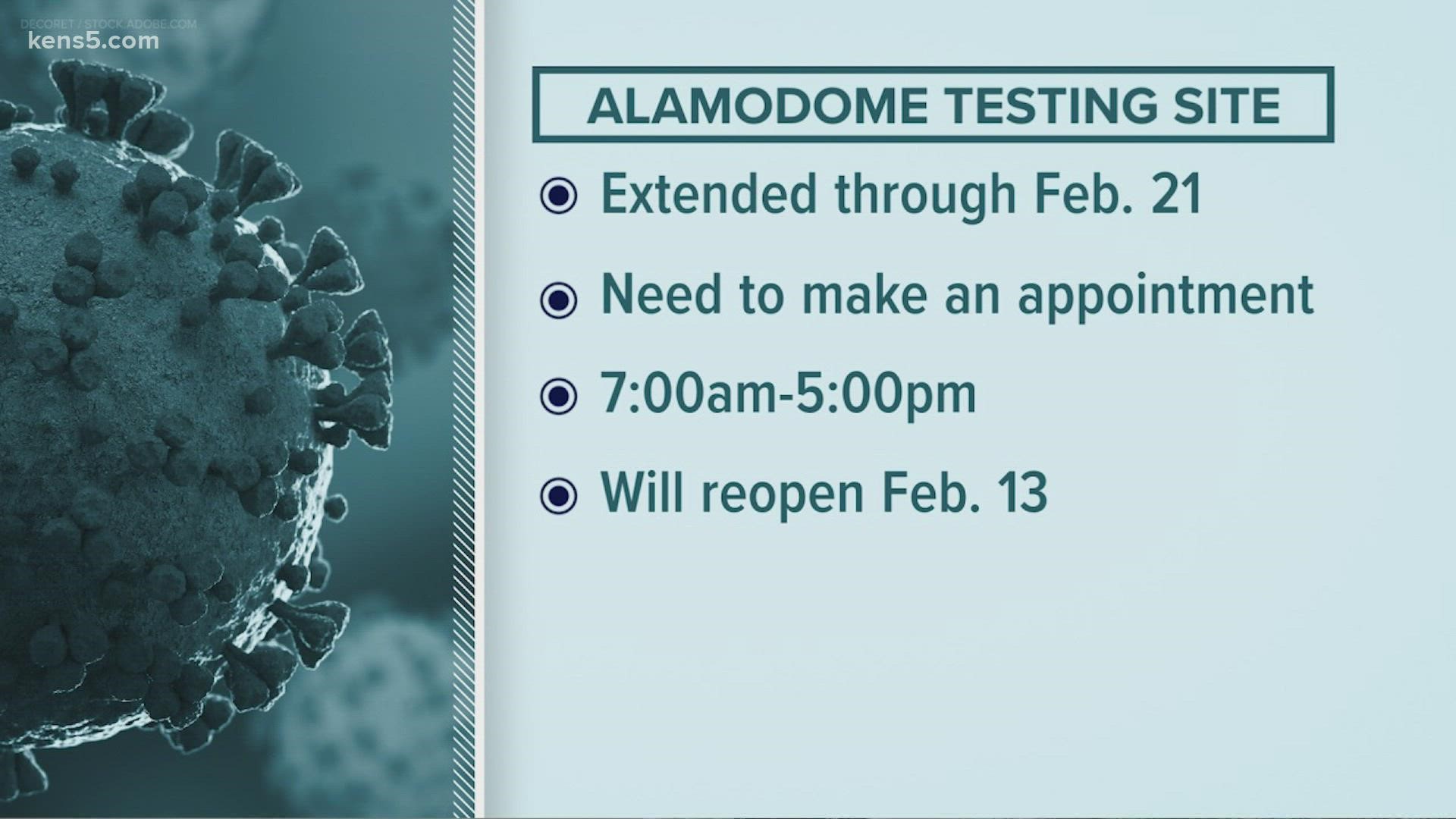SAN ANTONIO — For an eleventh day in a row, the seven-day average for new COVID-19 cases dropped in Bexar County as health authorities reported just 701 additional diagnoses Wednesday—the lowest daily count since Dec. 30.
The seven-day average now stands at 1,465, the lowest that figure has been since New Year's Day, before the San Antonio area's worst surge of the pandemic sent numbers skyrocketing to start the year.
January saw an average of nearly 4,800 new cases a day; so far in February, that number has been slashed to 1,955.
Hospitalizations also continue to go down for the community. On Wednesday there were 906 COVID-19 patients receiving treatment in local hospitals, which is 31 fewer compared to Tuesday. Hospitalizations have decreased by 22% over the last week.
Of those 906 patients, 236 are in intensive care and 114 are on ventilators.
Seven new virus-related deaths were also reported Wednesday, bringing the county's death toll to 5,171. Nearly 511,000 residents have been diagnosed with COVID-19 over the last two years.
Meanwhile, the city has announced slight adjustments in times for both its vaccine clinic and drive-thru testing site at the Alamodome, due to previously scheduled events.
How Bexar County is trending




Vaccine Progress in Bexar County
The following numbers are provided by San Antonio Metro Health. A full breakdown can be found here.
- 1.732 million eligible Bexar County residents have received at least one dose of the coronavirus vaccine as of Thursday, Feb. 3.
- 1.406 million eligible Bexar County residents are fully vaccinated as of Thursday, Feb. 3.
The CDC states that "when a high percentage of the community is immune to a disease (through vaccination and/or prior illness)," that community will have reached herd immunity, "making the spread of this disease from person to person unlikely."
The City of San Antonio breaks down the vaccination rates by zip code on Metro Health's Vaccination Statistics page.
Coronavirus in Texas
The total number of coronavirus cases in the state since the pandemic began grew by 12,587 on Wednesday, according to the Texas Department of State Health Services. That total includes 9,272 new confirmed cases and 3,315 new probable cases. More details can be found on this page.
Wednesday's figures bring the total number of Texans diagnosed with COVID-19 to more than 6.407 million.
An additional 294 Texans have died from virus complications, meanwhile, raising the statewide death toll to 80,005.
Coronavirus symptoms
The symptoms of coronavirus can be similar to the flu or a bad cold. Symptoms include fever or chills, cough, shortness of breath or difficulty breathing, fatigue, muscle or body aches, headache, new loss of taste or smell sore throat, congestion or runny nose, nausea or vomiting, and diarrhea, according to the Centers for Disease Control.
Most healthy people will have mild symptoms. A study of more than 72,000 patients by the Centers for Disease Control in China showed 80 percent of the cases there were mild.
But infections can cause pneumonia, severe acute respiratory syndrome, kidney failure, and even death, according to the World Health Organization. Older people with underlying health conditions are most at risk.
Experts determined there was consistent evidence these conditions increase a person's risk, regardless of age:
- Chronic kidney disease
- COPD (chronic obstructive pulmonary disease)
- Obesity (BMI of 30 or higher)
- Immunocompromised state (weakened immune system) from solid organ transplant
- Serious heart conditions, such as heart failure, coronary artery disease, or cardiomyopathies
- Sickle cell disease
- Type 2 diabetes
- The CDC believes symptoms may appear anywhere from two to 14 days after being exposed.
Human coronaviruses are usually spread...
- Between people who are in close contact with one another (within about 6 feet).
- Through respiratory droplets produced when an infected person coughs, sneezes or talks. These droplets can land in the mouths or noses of people who are nearby or possibly be inhaled into the lungs.
- Some recent studies have suggested that COVID-19 may be spread by people who are not showing symptoms.
Help stop the spread of coronavirus
- Stay home when you are sick.
- Eat and sleep separately from your family members
- Use different utensils and dishes
- Cover your cough or sneeze with your arm, not your hand.
- If you use a tissue, throw it in the trash.
Find a Testing Location
City officials recommend getting a COVID-19 test if you experience fever or chills, cough, shortness of breath or difficulty breathing, fatigue, muscle or body aches, headache, new loss of taste or smell, sore throat, congestion or runny nose, nausea or vomiting, or diarrhea.
Here's a Testing Sites Locator to help you find the testing location closest to you in San Antonio.
Latest Coronavirus Headlines
- Coronavirus Tracker: Metro Health reports Bexar County's lowest 2022 case count
- No, the alpha and beta variants of the coronavirus aren’t circulating in the US
- 'We failed on the social science': US reaches 900,000 COVID-19 deaths
- Dallas Zoo says 5 gorillas have tested positive for COVID-19
- COVID-19 protests threaten border trade between Canada, US
- Why are school lunches changing thanks to the COVID pandemic?
- Canadian provinces lift COVID restrictions, protests remain
- New COVID surge batters Afghanistan's crumbling healthcare system

